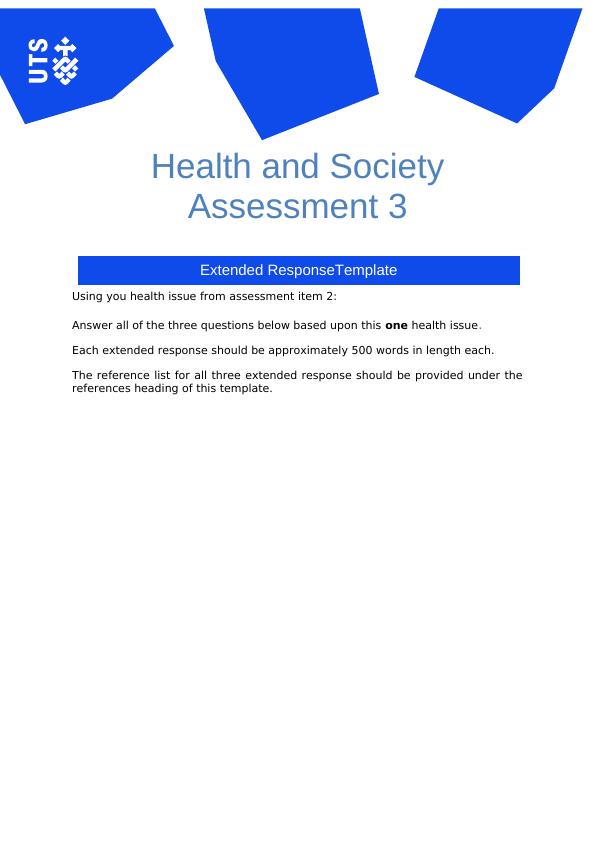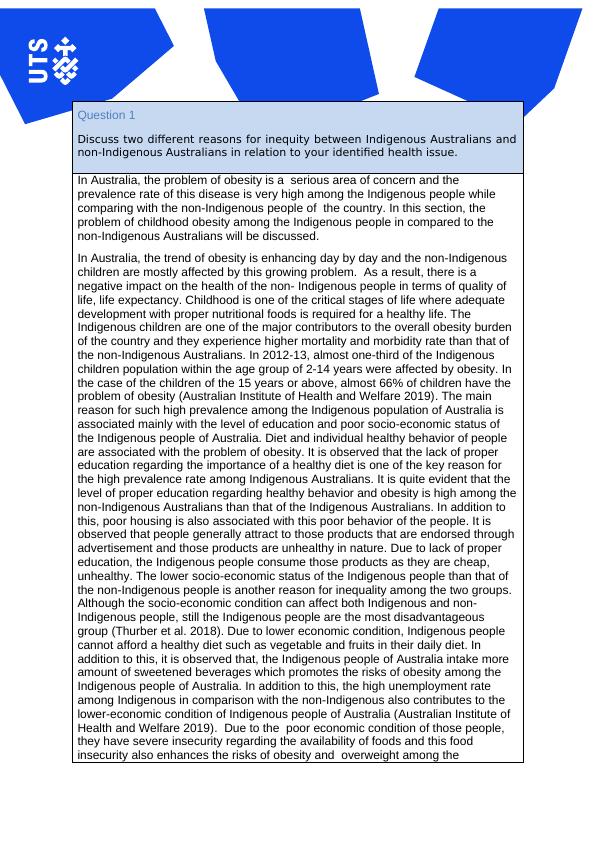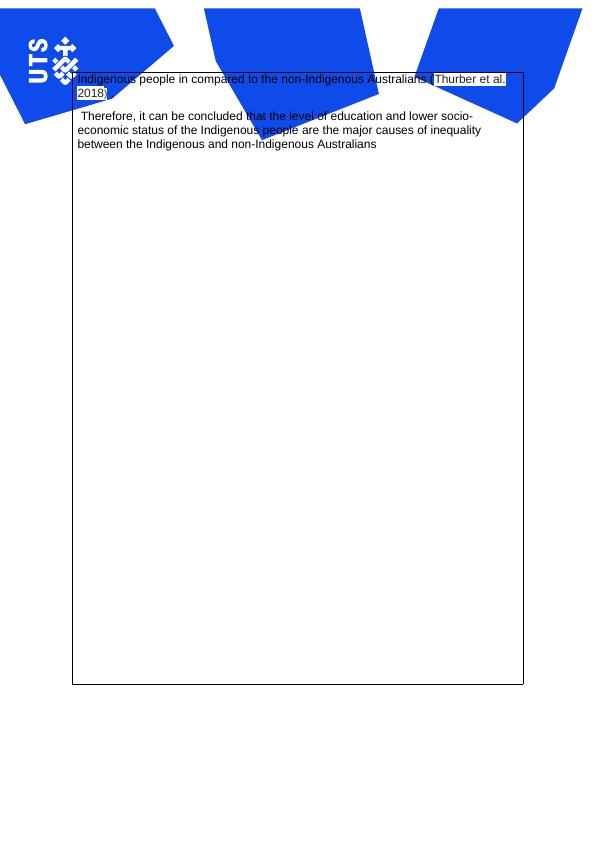Inequity between Indigenous and non-Indigenous Australians in relation to childhood obesity
Added on 2022-12-26
8 Pages2271 Words53 Views
Health and Society
Assessment 3
Extended ResponseTemplate
Using you health issue from assessment item 2:
Answer all of the three questions below based upon this one health issue.
Each extended response should be approximately 500 words in length each.
The reference list for all three extended response should be provided under the
references heading of this template.
Assessment 3
Extended ResponseTemplate
Using you health issue from assessment item 2:
Answer all of the three questions below based upon this one health issue.
Each extended response should be approximately 500 words in length each.
The reference list for all three extended response should be provided under the
references heading of this template.

Question 1
Discuss two different reasons for inequity between Indigenous Australians and
non-Indigenous Australians in relation to your identified health issue.
In Australia, the problem of obesity is a serious area of concern and the
prevalence rate of this disease is very high among the Indigenous people while
comparing with the non-Indigenous people of the country. In this section, the
problem of childhood obesity among the Indigenous people in compared to the
non-Indigenous Australians will be discussed.
In Australia, the trend of obesity is enhancing day by day and the non-Indigenous
children are mostly affected by this growing problem. As a result, there is a
negative impact on the health of the non- Indigenous people in terms of quality of
life, life expectancy. Childhood is one of the critical stages of life where adequate
development with proper nutritional foods is required for a healthy life. The
Indigenous children are one of the major contributors to the overall obesity burden
of the country and they experience higher mortality and morbidity rate than that of
the non-Indigenous Australians. In 2012-13, almost one-third of the Indigenous
children population within the age group of 2-14 years were affected by obesity. In
the case of the children of the 15 years or above, almost 66% of children have the
problem of obesity (Australian Institute of Health and Welfare 2019). The main
reason for such high prevalence among the Indigenous population of Australia is
associated mainly with the level of education and poor socio-economic status of
the Indigenous people of Australia. Diet and individual healthy behavior of people
are associated with the problem of obesity. It is observed that the lack of proper
education regarding the importance of a healthy diet is one of the key reason for
the high prevalence rate among Indigenous Australians. It is quite evident that the
level of proper education regarding healthy behavior and obesity is high among the
non-Indigenous Australians than that of the Indigenous Australians. In addition to
this, poor housing is also associated with this poor behavior of the people. It is
observed that people generally attract to those products that are endorsed through
advertisement and those products are unhealthy in nature. Due to lack of proper
education, the Indigenous people consume those products as they are cheap,
unhealthy. The lower socio-economic status of the Indigenous people than that of
the non-Indigenous people is another reason for inequality among the two groups.
Although the socio-economic condition can affect both Indigenous and non-
Indigenous people, still the Indigenous people are the most disadvantageous
group (Thurber et al. 2018). Due to lower economic condition, Indigenous people
cannot afford a healthy diet such as vegetable and fruits in their daily diet. In
addition to this, it is observed that, the Indigenous people of Australia intake more
amount of sweetened beverages which promotes the risks of obesity among the
Indigenous people of Australia. In addition to this, the high unemployment rate
among Indigenous in comparison with the non-Indigenous also contributes to the
lower-economic condition of Indigenous people of Australia (Australian Institute of
Health and Welfare 2019). Due to the poor economic condition of those people,
they have severe insecurity regarding the availability of foods and this food
insecurity also enhances the risks of obesity and overweight among the
Discuss two different reasons for inequity between Indigenous Australians and
non-Indigenous Australians in relation to your identified health issue.
In Australia, the problem of obesity is a serious area of concern and the
prevalence rate of this disease is very high among the Indigenous people while
comparing with the non-Indigenous people of the country. In this section, the
problem of childhood obesity among the Indigenous people in compared to the
non-Indigenous Australians will be discussed.
In Australia, the trend of obesity is enhancing day by day and the non-Indigenous
children are mostly affected by this growing problem. As a result, there is a
negative impact on the health of the non- Indigenous people in terms of quality of
life, life expectancy. Childhood is one of the critical stages of life where adequate
development with proper nutritional foods is required for a healthy life. The
Indigenous children are one of the major contributors to the overall obesity burden
of the country and they experience higher mortality and morbidity rate than that of
the non-Indigenous Australians. In 2012-13, almost one-third of the Indigenous
children population within the age group of 2-14 years were affected by obesity. In
the case of the children of the 15 years or above, almost 66% of children have the
problem of obesity (Australian Institute of Health and Welfare 2019). The main
reason for such high prevalence among the Indigenous population of Australia is
associated mainly with the level of education and poor socio-economic status of
the Indigenous people of Australia. Diet and individual healthy behavior of people
are associated with the problem of obesity. It is observed that the lack of proper
education regarding the importance of a healthy diet is one of the key reason for
the high prevalence rate among Indigenous Australians. It is quite evident that the
level of proper education regarding healthy behavior and obesity is high among the
non-Indigenous Australians than that of the Indigenous Australians. In addition to
this, poor housing is also associated with this poor behavior of the people. It is
observed that people generally attract to those products that are endorsed through
advertisement and those products are unhealthy in nature. Due to lack of proper
education, the Indigenous people consume those products as they are cheap,
unhealthy. The lower socio-economic status of the Indigenous people than that of
the non-Indigenous people is another reason for inequality among the two groups.
Although the socio-economic condition can affect both Indigenous and non-
Indigenous people, still the Indigenous people are the most disadvantageous
group (Thurber et al. 2018). Due to lower economic condition, Indigenous people
cannot afford a healthy diet such as vegetable and fruits in their daily diet. In
addition to this, it is observed that, the Indigenous people of Australia intake more
amount of sweetened beverages which promotes the risks of obesity among the
Indigenous people of Australia. In addition to this, the high unemployment rate
among Indigenous in comparison with the non-Indigenous also contributes to the
lower-economic condition of Indigenous people of Australia (Australian Institute of
Health and Welfare 2019). Due to the poor economic condition of those people,
they have severe insecurity regarding the availability of foods and this food
insecurity also enhances the risks of obesity and overweight among the

Indigenous people in compared to the non-Indigenous Australians (Thurber et al.
2018) .
Therefore, it can be concluded that the level of education and lower socio-
economic status of the Indigenous people are the major causes of inequality
between the Indigenous and non-Indigenous Australians
2018) .
Therefore, it can be concluded that the level of education and lower socio-
economic status of the Indigenous people are the major causes of inequality
between the Indigenous and non-Indigenous Australians

End of preview
Want to access all the pages? Upload your documents or become a member.
Related Documents
Childhood Obesity in Australia: Inequity between Indigenous and Non-Indigenous Australianslg...
|8
|2232
|5
Inequality in Indigenous Healthlg...
|8
|2163
|24
Inequity between Indigenous and non-Indigenous Australians in Cardiovascular Diseaselg...
|9
|2365
|88
Inequity between Indigenous and non-Indigenous Australians in relation to childhood obesitylg...
|8
|2223
|47
EVIDENCE-BASED NURSING PRACTICE-CHILDHOOD OBESITY.lg...
|8
|1990
|85
Childhood Obesity: Indigenous Children and Health Disparitieslg...
|9
|2566
|70